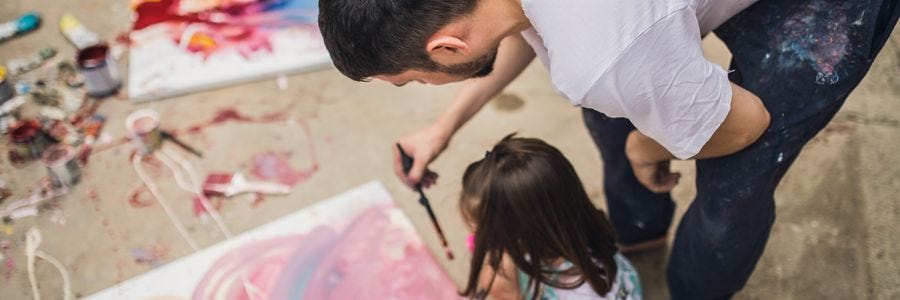Create, bond, throw some paint around and just have some fun! Making art with children is a rewarding and exciting activity that anyone can do. To help you get started, we’ve put together our top tips so that you can make a plan for success.
1. Find ideas
If you’re looking for ideas, YouTube is a great place to find fun art activities. Our channel has some fantastic projects for you to try with the kids, whether you’re in the zone for some hand print painting or a slime session. To get the kids excited, let them browse with you and choose an activity they really love.
2. Set up a dedicated space
Before you get started, set up a fun and safe area where you can all create. You don’t want to stifle children’s creativity, so choose an area away from anything valuable that could be stained, lay down a plastic sheet and let them go for it. This will help make the whole experience stress-free so that you’re not worrying about getting paint on the priceless Persian rug or the heirloom leather chesterfield lounge.
3. Wear old clothes
Mess is all part of the fun, so make sure you and your child are wearing old painting clothes, an art apron or an old rain coat.
4. Be ready to clean up
Accidents happen, so always have a bucket or tub of soapy water with a cloth on standby just in case.
5. Safety first
Make sure you keep an eye on young children when they’re making art and always choose paints and materials that are suitable for their age.
6. Let them lead and explore
Now for the fun part! Once you’ve set up your space, let the children have some creative control with the project. Children have a different way of thinking to adults, so let them embrace it. If they want to paint a purple tree or an orange sea, let them choose their own colours and express themselves.
This doesn’t mean you can’t teach them some basic colour mixing techniques, just remember Pablo Picasso’s famous quote that “All children are born artists, the problem is to remain an artist as we grow up”. Who knows, you might even end up learning something from them.
7. Date the artwork
Once they’ve finished their artwork, write the date on the back so that you don’t forget when it was made.
8. Hang up their artwork
Let the artworks dry and then hang them up in pride of place to encourage your child. A spot on the hallowed household fridge, where it can join the other curated collection of works, is a great place to put it on show. You might even like to have a frame on the coffee table where you can display the latest artwork. When it’s time to replace them with a new piece, store them safely in a folder.
9. Keep art supplies stocked up
Last, but not least, make sure you keep your child’s basic art supplies stocked up so that they can create whenever they feel like it. You don’t want art to be a chore, you want it to be something fun and exciting that can be done whenever inspiration strikes. So keep those supplies at the ready.
10. Organise your art supplies
Make it easy to dive into art activities by keeping your art supplies organised in labelled boxes or drawers. This is a great way to make art an easy go-to activity for kids (and it makes the whole process less stressful for you!).
Why is art important for children?
As well as being loads of fun, art plays an important role in childhood development (and it’s also beneficial for adults too!).
Brain development
Every time you engage in a creative activity, your brain creates new connections between cells and gets the right side of your brain (the creative side) communicating with the left side (the logical side). So, when we’re having fun making art, we are actually improving brain function and developing our problem solving skills. For the little ones, art is also a great exercise for fine motor skills, language development, decision making, visual learning and inventiveness.
Wellbeing
When children create art, they learn to observe and look at things in different ways. By giving them the opportunity to innovate and surprise themselves, art encourages optimistic attitudes, helps to boost self-esteem and fosters individuality. Plus, it’s a good opportunity to teach them how to clean up after themselves (they might not appreciate this last point at the time, but mum and dad will).
Set up a creative space and watch as your child explores, discovers and creates! As you go, you’ll learn what works best for your little artist and what they enjoy the most. So don’t worry if it’s a little bit tricky at first, as long as you’re both having fun you’re on the right track.





























